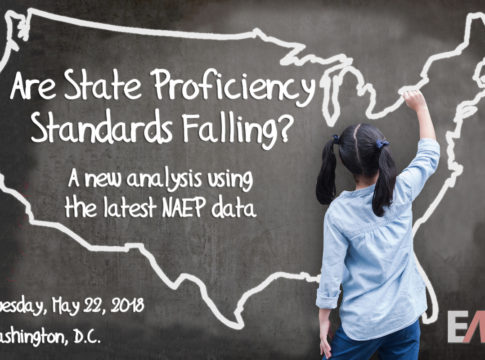Despite retreat from Common Core, states set high proficiency standards for students
But rising expectations for performance fail to translate into learning gains
May 22, 2018—Though once supported by 46 states, political backlash led several states to formally withdraw from the Common Core State Standards and many more to revise, or announce their intentions to revise, them. A new analysis from Daniel Hamlin and Paul E. Peterson of Harvard University shows that, despite the retreat from Common Core’s content standards, forty-nine states and Washington, D.C. have raised their proficiency standards since 2009. However, the study finds no relationship between rising standards for performance and higher student performance itself.
Using data from state tests and the National Assessment of Educational Progress (NAEP), a national exam that is widely recognized as maintaining a high bar for academic proficiency, Hamlin and Peterson compare across states and over time the differences between the percentage of students deemed proficient on the NAEP and the percentage reported to be proficient on state tests in each year. Each state is assigned a letter grade based on this comparison, with good grades indicating that students must perform at a high level to be considered proficient.
Among the key findings:
• Narrowing gap between state proficiency and NAEP proficiency. The percentage of students found to be proficient on state exams in 2009 was 37 percentage points higher in math and reading than NAEP. By 2015, that gap had narrowed to just 10 percent. Now, recently released data for 2017 reveal a difference of only 9 percent.
• No relationship between rising standards and growth in student learning. Comparing the average change in proficiency standards in each state between 2009 and 2017 and the average amount of growth in student test score performance on the NAEP reading and math exams in grades 4 and 8, Hamlin and Peterson find virtually no relationship between rising proficiency standards and test score growth over this time period.
• Dramatic gains over time for some states. Tennessee skyrocketed from an F grade in 2009 to an A in 2017. Illinois went from a D- to an A and Georgia from an F to a B+. In total, four of five states with F grades in 2009 achieved a C+ or higher in 2017, including Alabama, Georgia, Nebraska, and Tennessee. Nine of twenty-four states with a D- to D+ grades in 2009 received A grades in 2017, including: Arkansas, Illinois, Kansas, Maryland, New York, North Dakota, Oklahoma, Utah, and Wisconsin.
• Room for improvement for other states. Iowa and Minnesota made the least amount of progress between 2009 and 2017, going from a D to D+ and a C to B-, respectively. Missouri is the only state whose proficiency standards declined from 2009 to 2017, going from a B grade to a C. Iowa is the only state to receive a grade lower than a C- in 2017.
• Seventeen high-flier states. In 2017, 17 states received a grade A indicating that they have set a proficiency bar that is roughly comparable to that set by NAEP: Arkansas, Colorado, District of Columbia, Florida, Illinois, Kansas, Maryland, Massachusetts, New Jersey, New Mexico, New York, North Dakota, Oklahoma, Rhode Island, Tennessee, Utah, Wisconsin.
Although Hamlin and Peterson say it’s “disheartening” not to see high expectations associated with gains in student learning, they observe that it may simply be too soon to observe that connection, as it can take time for new standards to influence classroom practice. They point to Tennessee as an example of careful standards implementation leading to both rising standards and moderately improved student performance.
Series. Education Next has been tracking state proficiency standards since 2006. This study is the eighth in a series of articles ranking the rigor of states’ proficiency standards. For earlier findings see EdNext’s EdFacts at www.educationnext.org/edfacts.
Interactive maps. The year the online article will feature interactive maps showing the strength of state proficiency standards in 2017 state-by-state, as well as the change in standards between 2009 and 2017, and 2015 and 2017. A press preview of the maps is available here: unmappedcities.com/ednext/1804standards/map1804.html. (The interactive maps will be available at www.educationnext.org/rigor-state-proficiency-standards-map-2017 beginning at 12:01 AM ET on Tuesday, May 22, 2018.)
Release event. Join us on Tuesday, May 22 in Washington, D.C. to discuss the analysis and findings. For more details and to RSVP, visit the event page: www.educationnext.org/are-state-proficiency-standards-falling-new-analysis-2017-naep-data-event/.
To receive an embargoed copy of “Have States Maintained High Expectations for Student Performance? An analysis of 2017 state proficiency standards” or to speak with the authors, please contact Jackie Kerstetter at jackie.kerstetter@educationnext.org. The article will be available Tuesday, May 22 on www.educationnext.org and will appear in the Fall 2018 issue of Education Next, available in print on August 30, 2018.
About the Authors: Daniel Hamlin is a post-doctoral fellow in the Program on Education Policy and Governance at the Harvard Kennedy School. Paul E. Peterson, senior editor of Education Next, is professor of government and director of the Program on Education Policy and Governance at the Harvard Kennedy School.
About Education Next: Education Next is a scholarly journal committed to careful examination of evidence relating to school reform, published by the Education Next Institute and the Harvard Program on Education Policy and Governance at the Harvard Kennedy School. For more information, please visit www.educationnext.org.





